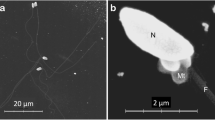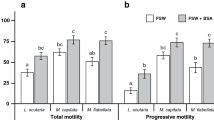Abstract
Although the quality of the spermatozoa is a key factor for reproductive success, there is few information describing the sperm quality for most marine invertebrates, especially corals. Given the high mortality rates and several threats currently faced by coral reefs, ways of assessing coral spermatozoa viability are needed. Thus, in this study we proposed a morphological classification for coral spermatozoa using Mussismilia harttii as model. In addition, we evaluated the relationship of morphology with the percentage and duration of motility. Spermatozoa were first classified into two main morphological categories: normal and abnormal. Then, we classified morphological abnormalities in the head and flagellum together with proposing subcategories that better described it. In general, 68.77 ± 6.50% of the spermatozoa had their whole structure intact, while 31.23 ± 6.51% had morphological abnormalities. Most abnormalities were in the flagellum (five types in total), while only two abnormalities were located in the head. Coiled flagellum and shortened flagellum were the most representative abnormalities, accounting for 24% of the total detected. We observed that reduction of sperm motility is directly related to increased morphological abnormalities and they are influenced by the cell ageing. Our results reinforce how the characterization of sperm morphology can be a practical and useful tool that can help to better understand the effects of multiple stressors on coral reproduction.
Graphical abstract







Similar content being viewed by others
Data availability
The data generated and analysed during this study are available from the corresponding author upon request.
References
Alavi SMH, Ciereszko A, Hatef A, Křišťan J, Dzyuba B, Boryshpolets S, Rodina M, Cosson J, Linhart O (2015) Sperm morphology, physiology, motility, and cryopreservation in Percidae. In: Kestemont P, Dabrowski K, Summerfelt RC (eds) Biology and culture of percid fishes: principles and practices. Springer, Dordrecht, pp 163–191. https://doi.org/10.1007/978-94-017-7227-3
Ax R, Dally M, Didion BA, Lenz RW, Love CC, Varner DD, Hafez B, Bellin ME (2016) Semen evaluation. In: Hafez ESE, Hafez B (eds) Reproduction in farm animals. Blackwell, South Carolina, SC, pp 365–375
Caldas JS, Godoy L (2019) Sperm characterization of the endangered Amazonian fish Hypancistrus zebra: basic knowledge for reproduction and conservation strategies. Anim Reprod Sci 204:117–124. https://doi.org/10.1016/j.anireprosci.2019.03.012
Chemes HE (2018) Phenotypic varieties of sperm pathology: genetic abnormalities or environmental influences can result in different patterns of abnormal spermatozoa. Anim Reprod Sci 194:41–56. https://doi.org/10.1016/j.anireprosci.2018.04.074
Chianese R, Pierantoni R (2021) Mitochondrial reactive oxygen species (ROS) production alters sperm quality. Antioxidants 10:1–19. https://doi.org/10.3390/antiox10010092
Cosson J (2019) Fish sperm physiology: structure, factors regulating motility, and motility evaluation. Biol Res Aquat Sci. https://doi.org/10.5772/intechopen.85139
Czubaszek M, Andraszek K, Banaszewska D, Walczak-Jędrzejowska R (2019) The effect of the staining technique on morphological and morphometric parameters of boar sperm. PLoS ONE 14:1–17. https://doi.org/10.1371/journal.pone.0214243
Fernandes JFF, França CL, Santana TC, Lobato RS, Teixeira EG (2020) Contribuição técnica: identificação de anomalias espermáticas no sêmen in natura de curimatã (Prochilodus lacustris) (Steindachner, 1907). Brazilian J Dev 6:10418–10431. https://doi.org/10.34117/bjdv6n3-064
García-Vázquez F, Gadea J, Matás C, Holt W (2016) Importance of sperm morphology during sperm transport and fertilization in mammals. Asian J Androl 18:844–850. https://doi.org/10.4103/1008-682X.186880
Godoy L, Mies M, Zilberberg C, Pastrana Y, Amaral A, Cruz N, Pereira CM, Garrido AG, Paris A, Santos LFA, Pires DO (2021) Southwestern Atlantic reef-building corals Mussismilia spp. are able to spawn while fully bleached. Mar Biol 168:15. https://doi.org/10.1007/s00227-021-03824-z
Hagedorn M, Carter VL, Steyn RA, Krupp D, Leong JC, Lang RP, Tiersch TR (2006) Preliminary studies of sperm cryopreservation in the mushroom coral, Fungia scutaria. Cryobiology 52:454–458. https://doi.org/10.1016/j.cryobiol.2006.03.001
Hughes TP, Kerry JT, Baird AH, Connolly SR, Chase TJ, Dietzel A, Hill T, Hoey AS, Hoogenboom MO, Jacobson M, Kerswell A, Madin JS, Mieog A, Paley AS, Pratchett MS, Torda G, Woods RM (2019) Global warming impairs stock–recruitment dynamics of corals. Nature 568:387–390. https://doi.org/10.1038/s41586-019-1081-y
Kaya A, Birler S, Enwall L, Memili E (2014) Determinants of sperm morphology. Animal andrology: theories and applications. CAB International, UK, pp 34–56
Kholodnyy V, Gadêlha H, Cosson J, Boryshpolets S (2020) How do freshwater fish sperm find the egg? The physicochemical factors guiding the gamete encounters of externally fertilizing freshwater fish. Rev Aquac 12:1165–1192. https://doi.org/10.1111/raq.12378
Kowalski RK, Cejko BI (2019) Sperm quality in fish: determinants and affecting factors. Theriogenology 135:94–108. https://doi.org/10.1016/j.theriogenology.2019.06.009
Kumaresan A, Das Gupta M, Datta TK, Morrell JM (2020) Sperm DNA integrity and male fertility in farm animals: a review. Front Vet Sci 7:1–15. https://doi.org/10.3389/fvets.2020.00321
Leão ZMAN, Kikuchi RKP, Ferreira BP, Neves EG, Sovierzoski HH, Oliveira MDM, Maida M, Correia MD, Johnsson R (2016) Brazilian coral reefs in a period of global change: a synthesis. Brazilian J Oceanogr 64:97–116. https://doi.org/10.1590/S1679-875920160916064sp2
Leelatanawit R, Uawisetwathana U, Khudet J, Klanchui A, Phomklad S, Wongtripop S, Angthoung P, Jiravanichpaisal P, Karoonuthaisiri N (2014) Effects of polychaetes (Perinereis nuntia) on sperm performance of the domesticated black tiger shrimp (Penaeus monodon). Aquaculture 433:266–275. https://doi.org/10.1016/j.aquaculture.2014.06.034
Lewis C, Ford AT (2012) Infertility in male aquatic invertebrates: a review. Aquat Toxicol 120–121:79–89. https://doi.org/10.1016/j.aquatox.2012.05.002
Menkveld R, Holleboom CAG, Rhemrev JPT (2011) Measurement and significance of sperm morphology. Asian J Androl 13:59–68. https://doi.org/10.1038/aja.2010.67
Oehninger S, Franken DR, Ombelet W (2014) Sperm functional tests. Fertil Steril 102:1528–1533. https://doi.org/10.1016/j.fertnstert.2014.09.044
Pires DO, Castro CB, Ratto CC (1999) Reef coral reproduction in the abrolhos reef complex, Brazil: the endemic genus Mussismilia. Mar Biol 135:463–471. https://doi.org/10.1007/s002270050646
Rodrigues J, Dos SRS, Cordeiro JG, Leite M, Oliveira HSTOE, Tercya H, Costa BPD, Do NNF, Maximino C, De Siqueira-Silva DH (2020) Seminal characterization of the Amazonian fire-eye tetra Moenkhausia oligolepis (Günther, 1864). Zygote. https://doi.org/10.1017/S0967199420000325
Roldan ERS (2020) Assessments of sperm quality integrating morphology, swimming patterns, bioenergetics and cell signalling. Theriogenology 150:388–395. https://doi.org/10.1016/j.theriogenology.2020.02.017
Shabtaie SA, Gerkowicz SA, Kohn TP, Ramasamy R (2016) Role of abnormal sperm morphology in predicting pregnancy outcomes. Curr Urol Rep. https://doi.org/10.1007/s11934-016-0623-1
Steiner SCC (1998) La ultraestructura de espermatozoides y su valor en la sistemática de Scleractinia (Cnidaria: Anthozoa). Ver Biol Trop. 5:127–135
Acknowledgements
Coral Vivo Project and its sponsors, Petrobras, through the Petrobras Socioambiental Program, and Arraial d’Ajuda Eco Parque are acknowledged for funding field research and for the use of their research facilities. We are grateful for the funding support from Boticário Group Foundation for Nature Protection. We acknowledge the Experimental Laboratory of Physiology and Behavior of Aquatic Animals (LEFCAQ) of the Federal University of Amazonas (UFAM) for the use of laboratory facilities. AA was granted a master scholarship from CAPES-Brazil (88882.365917/2019-01). WV was granted a field-research scholarship from the Brazilian Biodiversity Fund (Funbio) and Instituto Humanize (N° 121/2019). LG is a research fellow from CNPq-Brazil (310463/2018-1).
Funding
Coordenação de Aperfeiçoamento de Pessoal de Nível Superior, 88882.365917/2019-01,Amanda Amaral, Brazilian Biodivesity Fund,121/2019, Wanderson Valente,Conselho Nacional de Desenvolvimento Científico e Tecnológico,310463/2018-1,Leandro Godoy, Fundação Grupo Boticário de Proteção à Natureza, 1138/2018-2, Leandro Godoy.
Author information
Authors and Affiliations
Contributions
AA, LG and YP designed the study; AA, LG, YP and CP performed the experiments; AA and WV performed morphological and morphometric analysis and graphic illustration; and all authors contributed to the manuscript.
Corresponding author
Ethics declarations
Conflict of interest
On behalf of all authors, the corresponding author states that there is no conflict of interest.
Ethical approval
The authors declare that all applicable international, national and/or institutional guidelines for sampling, care and experimental use of animals for the study have been followed, all and necessary approvals by the Chico Mendes Institute for Biodiversity Conservation – ICMBio (SISBIO N° 63368–1) have been obtained.
Additional information
Responsible Editor: S. Harii.
Publisher's Note
Springer Nature remains neutral with regard to jurisdictional claims in published maps and institutional affiliations.
Rights and permissions
Springer Nature or its licensor holds exclusive rights to this article under a publishing agreement with the author(s) or other rightsholder(s); author self-archiving of the accepted manuscript version of this article is solely governed by the terms of such publishing agreement and applicable law.
About this article
Cite this article
Amaral, A., Pastrana, Y., Pereira, C. et al. Morphological assessment of free-spawned sperm in scleractinian coral: a relationship between cell morphology and motility. Mar Biol 169, 136 (2022). https://doi.org/10.1007/s00227-022-04124-w
Received:
Accepted:
Published:
DOI: https://doi.org/10.1007/s00227-022-04124-w




